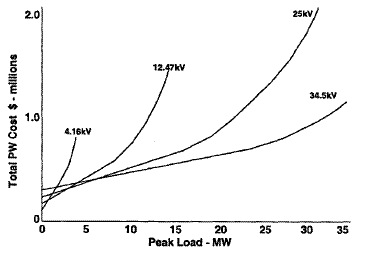1- انتخاب سطح ولتاژ شبکه توزیع اساساً یک انتخاب فنی- اقتصادی است که می باید با توجه به وسعت شبکه، میزان تقاضا و پیش بینی رشد مصرف همچنین شیب رشد تقاضا انجام شود. در شکل زیر نمونه ای از یک برآورد اقتصادی آمده است. برای مثال سطح ولتاژ 33 کیلو ولت برای مناطق با وسعت جغرافیایی زیاد،میزان تقاضای بالا همچنین سرعت رشد تقاضای قابل توجه بر سطح ولتاژ 20 کیلو ولت ترجیح داده می شود. ازینرو به نظر می رسد انتخاب سطح ولتاژ 33 کیلو ولت برای شبکه برق خوزستان با توجه به تجمع صنایع نفتی در آن و پیش بینی رشد تقاضای قابل توجه انتخابی بدون مطالعه نبوده باشد.  Behavior of overall cost versus peak load for various phase-to-phase voltages, based on urban/suburban construction costs and 30-year PW costs of O&M and losses for a utility in the mid United States, for conductor utilization with loading ranges adjusted in all cases to the “natural” economic load reach of the smaller conductors in the set. Losses are computed based on an 8760-hour loss factor in terms of the peak load plotted, and no load growth was assumed. Costs are reported here in relative terms because the authors do not want readers to over interpret the results – actual values from such an analysis are not general to all situations. Furthermore, the fact that 25 kV offers a lower cost per mile than 12.47 kV for all loads above 2.3 MW may be irrelevant in determining primary voltage selection, even in a system where every feeder has a peak load well above that value. What many planners forget to consider is that for every mile of “big wire” trunk loaded to a relatively high value for distribution (e.g., above 5 MVA), there are literally dozens of miles of minimal-wire laterals and branches loaded to less than 1.5 MVA, for which the fixed costs of a higher voltage makes it an “expensive” solution. Usually higher voltages will justify themselves when most if not all of the their greater load reach is needed to meet system needs due to substation spacing. The economy they provide in moving larger amounts of power will add to the advantage they have
Behavior of overall cost versus peak load for various phase-to-phase voltages, based on urban/suburban construction costs and 30-year PW costs of O&M and losses for a utility in the mid United States, for conductor utilization with loading ranges adjusted in all cases to the “natural” economic load reach of the smaller conductors in the set. Losses are computed based on an 8760-hour loss factor in terms of the peak load plotted, and no load growth was assumed. Costs are reported here in relative terms because the authors do not want readers to over interpret the results – actual values from such an analysis are not general to all situations. Furthermore, the fact that 25 kV offers a lower cost per mile than 12.47 kV for all loads above 2.3 MW may be irrelevant in determining primary voltage selection, even in a system where every feeder has a peak load well above that value. What many planners forget to consider is that for every mile of “big wire” trunk loaded to a relatively high value for distribution (e.g., above 5 MVA), there are literally dozens of miles of minimal-wire laterals and branches loaded to less than 1.5 MVA, for which the fixed costs of a higher voltage makes it an “expensive” solution. Usually higher voltages will justify themselves when most if not all of the their greater load reach is needed to meet system needs due to substation spacing. The economy they provide in moving larger amounts of power will add to the advantage they have
